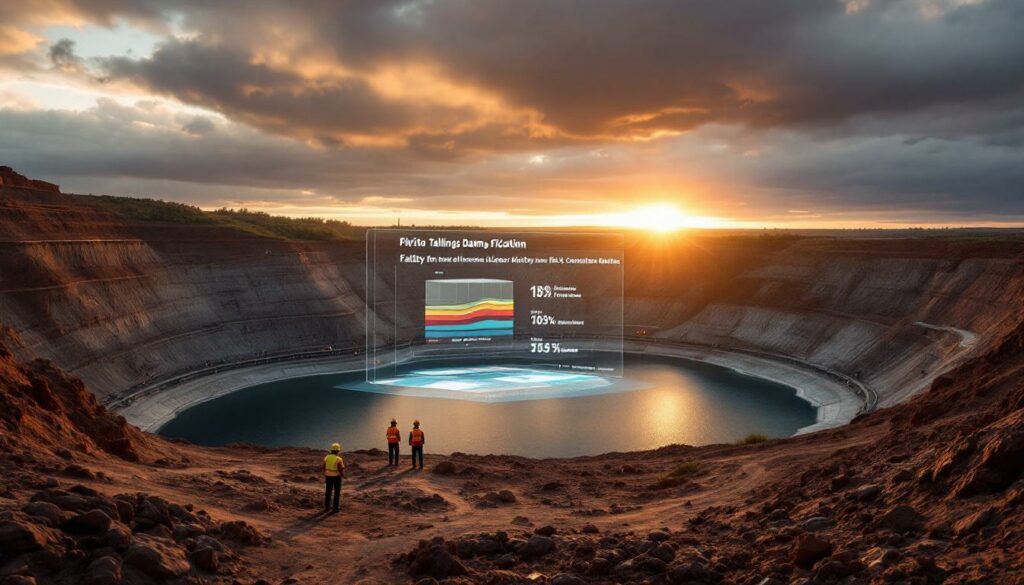Understanding Tailings Management: Rio Tinto's Commitment to Safety and Transparency
Tailings management represents one of the most critical safety and environmental responsibilities in the mining industry. As Rio Tinto updates tailings information publicly, it demonstrates an ongoing commitment to transparency and responsible resource development. This comprehensive approach highlights how proper tailings management protects communities, environments, and the mining industry's social license to operate.
What are Tailings Facilities and Why Do They Matter?
Tailings facilities serve as essential infrastructure for modern mining operations. These engineered structures contain the residual materials left after extracting valuable minerals from ore. Despite their technical nature, understanding tailings management is crucial for anyone concerned with mining safety and environmental protection.
The Critical Role of Tailings in Mining Operations
Tailings consist primarily of crushed rock, water, and processing chemicals that remain after valuable minerals have been extracted from ore. These byproducts require careful containment to prevent environmental contamination and protect surrounding communities.
Unlike ordinary waste, tailings often contain trace amounts of metals, minerals, and processing reagents that could potentially impact ecosystems if improperly managed. The implementation of effective waste management solutions has become increasingly important as the volume of tailings produced typically exceeds the volume of the original ore extracted, creating significant storage challenges.
Modern mining operations generate millions of tons of tailings annually, necessitating robust management systems that can safely contain these materials for decades or even centuries. As Rio Tinto updates tailings information for public review, it highlights the scale and importance of this aspect of mining operations.
The Evolution of Tailings Management Standards
The mining industry's approach to tailings management has evolved dramatically, particularly following catastrophic failures that prompted global action. The Samarco dam collapse in 2015 and the Brumadinho disaster in 2019 served as watershed moments that transformed industry standards.
The Brumadinho failure resulted in 270 lives lost when the dam collapsed, releasing 12 million cubic meters of mining waste. This tragedy followed the earlier Samarco disaster that killed 19 people and contaminated 650 kilometers of rivers, ultimately reaching the Atlantic Ocean.
These devastating events catalyzed unprecedented collaboration among mining companies, investors, and international organizations to develop more rigorous safety standards. The industry recognized that traditional approaches to tailings management required fundamental reconsideration, leading to significant industry evolution trends in safety protocols.
"Managing tailings responsibly is essential for keeping people, communities and the environment safe from harm and is fundamental to maintaining our social licence," notes Mark Davies, Rio Tinto chief technical officer.
What is the Global Industry Standard on Tailings Management (GISTM)?
The Global Industry Standard on Tailings Management represents the mining industry's response to catastrophic failures and the recognition that more robust governance frameworks are essential for preventing future disasters.
GISTM Framework and Requirements
Established in August 2020, the GISTM emerged directly from the tragedies at Samarco and Brumadinho. This comprehensive framework consists of 15 principles and 77 detailed requirements that apply to tailings facilities worldwide.
The standard applies to both existing facilities and those under development, requiring operators to conduct thorough self-assessments followed by independent third-party audits to verify compliance. Results must be published publicly to ensure transparency and accountability.
Key principles include:
- Developing knowledge about the social, environmental, and local economic context
- Integrating social, environmental, and technical considerations into all stages of the tailings facility lifecycle
- Designing, constructing, operating, and managing tailings facilities based on the assumption that preventing catastrophic failure takes precedence over all other considerations
- Establishing comprehensive monitoring systems
- Implementing emergency preparedness and response plans for potential failures
The standard clearly establishes that catastrophic failures with extreme consequences are fundamentally unacceptable, shifting the industry paradigm from risk management to risk elimination.
Classification System for Risk Assessment
The GISTM introduces a rigorous classification system that rates facilities based on the potential consequences of failure. This system helps prioritize resources and attention according to risk levels:
| Classification | Potential Consequences |
|---|---|
| Low | Limited impacts to ecosystems, infrastructure, cultural sites |
| Significant | Notable impacts to ecosystems, infrastructure; no loss of life expected |
| High | Potential for loss of life and significant environmental damage |
| Very High | Potential for multiple fatalities and severe, widespread environmental damage |
| Extreme | Potential for numerous fatalities and catastrophic, irreversible environmental harm |
As Rio Tinto updates tailings information, it reveals that 14 of its facilities fall into the "very high" or "extreme" consequence categories, with an additional 84 facilities rated as "low," "high," or "significant." This transparent classification enables stakeholders to understand the potential risks associated with each facility.
How is Rio Tinto Implementing the GISTM Standards?
Rio Tinto's implementation of the GISTM demonstrates how major mining companies are responding to heightened expectations for tailings management. The company's approach combines transparency, technical rigor, and community engagement.
Rio Tinto's Disclosure Initiative
As Rio Tinto updates tailings information, it has recently published comprehensive data on 14 global tailings facilities with the highest consequence classifications. This disclosure represents a significant step in transparency for the mining industry.
The company has also released detailed information on an additional 84 facilities with various risk ratings across its global operations. This information is accessible through an interactive map that allows stakeholders to view facility locations, technical specifications, and risk classifications.
This unprecedented level of disclosure enables:
- Communities to understand the tailings facilities in their vicinity
- Regulators to verify compliance with standards
- Investors to assess risk management practices
- Environmental organizations to monitor potential impacts
- Industry peers to benchmark best practices
Classification of Rio Tinto's Tailings Portfolio
Rio Tinto's tailings facilities span a wide spectrum of risk classifications, with 14 facilities designated as having "very high" or "extreme" consequence ratings. These classifications are based on potential impacts in hypothetical failure scenarios, not on the current condition or stability of the facilities.
These higher-risk facilities receive enhanced monitoring, more frequent inspections, and more robust management protocols. Additionally, 84 facilities are classified in the "low," "high," or "significant" categories, each with tailored management approaches based on their specific risk profiles.
"We are proud to share our management practices transparently and to partner with local communities, our industry peers and regulators to drive transformative improvements in tailings management," says Davies.
Rio Tinto has committed to a five-year implementation program for bringing all facilities into conformance with the GISTM. According to Davies, "Rio Tinto has committed to implementing the GISTM at all our tailings facilities and we have been working hard over the past five years to bring these into conformance. We have made significant progress and have detailed plans in place to complete the few outstanding items."
What Types of Tailings Facilities Does Rio Tinto Operate?
Rio Tinto's global operations include diverse tailings management approaches tailored to specific geological, environmental, and operational contexts. Understanding these different approaches provides insight into the complexity of modern tailings management.
Diverse Tailings Management Approaches
The company employs several distinct approaches to tailings storage:
Engineered Earthen Embankments: These traditional tailings dams use carefully designed and constructed earthen walls to contain conventional tailings. These structures require ongoing monitoring and maintenance to ensure stability.
In-Pit Disposal: This approach utilizes previously mined open pits as tailings repositories, minimizing the need for new containment structures. In-pit disposal can reduce surface footprints and sometimes offers greater geological stability.
Single-Phase Embankments: Constructed in one stage to their full height, these structures are built completely before tailings deposition begins. This approach often provides greater initial stability but requires significant upfront investment.
Multi-Raised Embankments: Developed incrementally over time, these facilities grow as mining operations continue. While allowing for phased capital investment, they require careful planning and execution during each raising phase.
Each approach carries distinct advantages and challenges, with selection depending on factors including:
- Local topography and geology
- Climate conditions and precipitation patterns
- Earthquake risk and seismic considerations
- Proximity to communities and sensitive ecosystems
- Expected volume and characteristics of tailings
- Mine life and production schedule
- Regulatory requirements in the operating jurisdiction
Safety and Management Protocols
Rio Tinto has developed comprehensive safety protocols for its tailings facilities at various lifecycle stages. These protocols include:
-
Design and Construction: Facilities are designed by qualified engineers following international standards, with independent review of designs and construction quality.
-
Operation: Regular inspections, instrumentation monitoring, and performance evaluations against design parameters ensure ongoing safety.
-
Closure: Long-term stability plans, including surface water management, erosion control, and monitoring systems, prepare facilities for post-mining conditions.
-
Post-Closure: Continued surveillance and maintenance ensure facilities remain stable and environmentally secure long after mining operations cease.
Advanced technologies deployed across Rio Tinto's tailings portfolio include:
- Automated monitoring systems that provide real-time data on structural performance
- Remote sensing technologies that detect subtle changes in embankment conditions
- Piezometers that measure water pressure within dam structures
- Inclinometers that detect movement or deformation
- Drone and satellite surveillance for regular visual assessments
Why is Responsible Tailings Management Essential?
Responsible tailings management extends beyond technical compliance—it represents a fundamental commitment to environmental stewardship and community safety. As Rio Tinto updates tailings information, it underscores the importance of this aspect of mining operations.
Environmental and Social Considerations
Proper tailings management protects ecosystems from potential contamination that could otherwise persist for generations. Tailings often contain fine particles that, if released, could impact soil and water quality across large areas.
Tailings facilities can affect:
- Surface water quality in nearby streams, rivers, and lakes
- Groundwater resources used by communities and ecosystems
- Soil quality and agricultural productivity
- Wildlife habitat and biodiversity
- Air quality through dust generation
The environmental footprint of tailings facilities can extend for kilometers beyond the mine site, making their proper management critical for regional environmental protection. Effective tailings management includes measures to:
- Control seepage of process water
- Prevent erosion and dust generation
- Manage surface water runoff
- Monitor surrounding environmental conditions
- Rehabilitate surfaces for post-mining land uses
Community Safety and Social License
For communities near mining operations, tailings management represents one of the most visible aspects of a company's commitment to safety and responsible operation. Transparent tailings management builds trust with local communities through:
- Open communication about facility designs and safety measures
- Community involvement in emergency planning
- Regular updates on monitoring results and performance
- Clear explanation of risk management approaches
- Accessible information about facility classifications and potential impacts
As Mark Davies notes, "Managing tailings responsibly is essential for keeping people, communities and the environment safe from harm and is fundamental to maintaining our social licence."
This social license—the ongoing acceptance of mining operations by local communities and broader society—depends increasingly on demonstrable commitments to safety and environmental protection. Through its disclosure initiatives, Rio Tinto aims to strengthen this social license by demonstrating accountability and transparency.
How Does Rio Tinto's Approach Compare to Industry Standards?
Rio Tinto's approach to tailings management demonstrates leadership within an industry undergoing rapid transformation. As Rio Tinto updates tailings information, it establishes benchmarks for transparency and comprehensive management.
Leadership in Tailings Management
Rio Tinto's five-year implementation program for GISTM compliance represents a substantial commitment to raising standards across its global operations. The company has reported significant progress, with detailed plans for addressing remaining requirements.
The company's disclosure of facility information and risk assessments exceeds regulatory requirements in many jurisdictions, setting a higher standard for transparency in the mining industry. This approach aligns with growing expectations from:
- Investors seeking better risk management and disclosure
- Communities demanding greater transparency
- Regulators moving toward more stringent requirements
- Industry associations promoting better standards
By publishing detailed information on 98 facilities worldwide, Rio Tinto has created one of the most comprehensive public databases of tailings information from any mining company. This level of disclosure enables meaningful assessment of the company's tailings management approach.
Ongoing Improvement Initiatives
Rio Tinto continues to invest in tailings management technologies and expertise, recognizing that standards and best practices continue to evolve. These investments include:
- Development of specialized internal expertise in geotechnical engineering
- Regular review and updating of management practices
- Collaboration with industry peers on advancing standards
- Research into innovative approaches to tailings management
The company participates in industry-wide initiatives to improve tailings management practices, contributing to collective knowledge and raising standards across the sector. This collaborative approach recognizes that tailings safety represents a shared responsibility among mining companies.
What Are the Future Directions in Tailings Management?
The mining industry continues to evolve its approach to tailings management, with emerging technologies and methodologies promising safer, more sustainable practices. As Rio Tinto updates tailings information, it also looks toward future innovations.
Emerging Technologies and Approaches
Several technological advancements are transforming tailings management:
- Real-time monitoring systems that use Internet of Things (IoT) sensors to provide continuous data on dam conditions, enabling earlier detection of potential issues
- Predictive analytics that use artificial intelligence to identify patterns and predict potential problems before they develop
- Tailings reprocessing technologies that extract additional minerals from stored tailings, potentially reducing storage volumes while generating economic value
- Filtered tailings approaches that remove more water before storage, creating more stable, less liquid material
- Co-disposal methods that combine tailings with waste rock to improve stability
- Underground tailings placement that returns processed material to mined-out areas underground
These innovations represent potential paradigm shifts in how the industry manages tailings, moving toward approaches that minimize risk while potentially recovering additional resources. The integration of data-driven operations is further enhancing monitoring capabilities and predictive maintenance.
Industry Collaboration Opportunities
The future of tailings management increasingly depends on collaboration across companies, jurisdictions, and stakeholders. Key collaboration opportunities include:
- Knowledge sharing through industry associations and technical forums
- Joint research initiatives to develop new technologies and approaches
- Standardized reporting frameworks that enable meaningful comparison of performance
- Collective action to improve global tailings safety standards
- Community engagement models that incorporate diverse perspectives into management decisions
These collaborative efforts recognize that tailings management represents both a shared challenge and responsibility for the mining industry. Furthermore, advancing sustainability transformation within the mining sector will continue to drive improvements in tailings management practices.
FAQ: Understanding Tailings Management
What happens if a tailings facility fails?
Tailings facility failures can have catastrophic consequences, including:
- Release of large volumes of tailings material into the environment
- Potential loss of human life in downstream communities
- Contamination of water sources used for drinking and agriculture
- Destruction of aquatic habitats and wildlife
- Long-term ecological damage that may persist for decades
- Substantial remediation costs often reaching billions of dollars
- Regulatory penalties and legal liabilities
- Loss of social license to operate for the company and potentially the broader industry
The severity of impacts depends on factors including facility size, tailings characteristics, proximity to communities, and local geography. The industry's focus on prevention recognizes that the consequences of failure are simply unacceptable.
How often are tailings facilities inspected?
Inspection frequencies vary based on facility risk classification, with higher-consequence facilities receiving more frequent attention:
- Daily to weekly visual inspections by site personnel
- Monthly to quarterly inspections by qualified engineers
- Annual comprehensive reviews by independent experts
- Special inspections following significant rainfall, seismic events, or other unusual conditions
- Formal dam safety reviews every 3-5 years by external specialists
Modern facilities also employ continuous monitoring technologies that provide real-time data on key performance indicators, supplementing regular physical inspections.
What information can the public access about tailings facilities?
As Rio Tinto updates tailings information, the public can access:
- Facility locations and basic specifications
- Risk classifications and potential consequence ratings
- Management approaches and safety measures
- Conformance status with industry standards
- Historical performance and incidents
- Emergency response plans and procedures
- Technical documentation including design reports
This information is increasingly available through company websites, regulatory filings, and industry association databases. The trend toward greater transparency represents a significant shift in how mining companies communicate about tailings risks.
How long must tailings facilities be maintained?
Tailings facilities require management long after mining operations cease:
- Active management continues throughout the operational life of the mine
- Closure periods typically require intensive monitoring and maintenance
- Post-closure periods may extend indefinitely for some facilities
- Some facilities require perpetual monitoring and maintenance
- Financial provisions must be made for long-term care
The "design life" of tailings facilities often extends hundreds of years—effectively requiring perpetual management in human terms. This long-term responsibility represents one of the mining industry's most significant sustainability challenges and has driven innovation in mine reclamation innovation.
The Path Forward for Sustainable Tailings Management
Rio Tinto's approach to tailings management demonstrates a commitment to safety, transparency, and continuous improvement. As Rio Tinto updates tailings information publicly, it contributes to raising standards across the mining industry.
Want to Stay Ahead of Major Mineral Discoveries?
Discover how ASX resource investors gain their market edge with Discovery Alert's proprietary Discovery IQ model, delivering real-time notifications on significant mineral discoveries as they are announced. Visit the Discovery Alert discoveries page to see how major mineral discoveries can transform portfolio returns.




